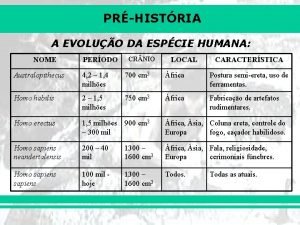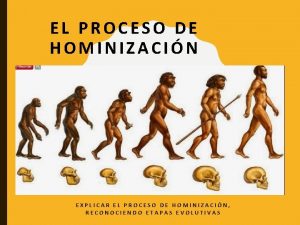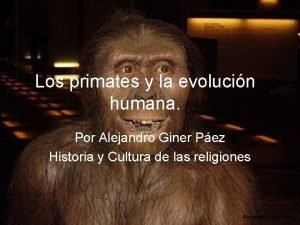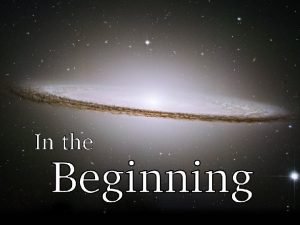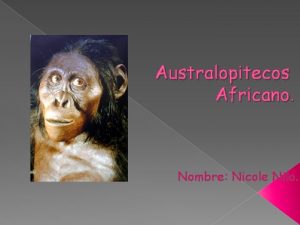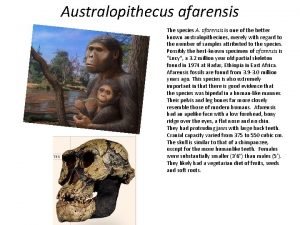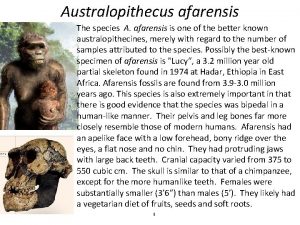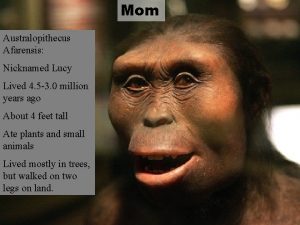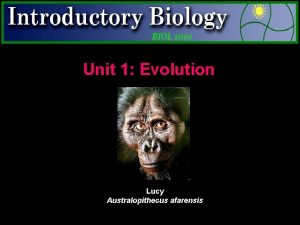Australopithecus afarensis lived 3 9 and 2 8





- Slides: 5

Australopithecus afarensis lived 3. 9 and 2. 8 million years ago • Australopithecus means ‘southern ape’ and was originally developed for a species found in South Africa. This is the genus or group name and several closely related species now share this name. afarensis is based on the location where some of the first fossils for this species were discovered – the Afar Depression in Ethiopia, Africa • Relationships with other species Australopithecus afarensis is usually considered to be a direct ancestor of humans and a direct ancestor of later species of Australopithecus • Environment and diet: occupied a range of environments. Some populations lived in savannah or sparse woodland, others lived in denser forests beside lakes. Analysis of their teeth, skull and body shape indicates a diet that consisted mainly of plants. Microscopic analysis of their tooth enamel shows that they mostly ate fruits and leaves rather than seeds and other hard plant material. The position of the sagittal crest toward the back of the skull indicates that the front teeth processed most of the food. • Fossils show this species was bipedal (able to walk on two legs) but still retained many ape-like features including adaptations for tree climbing, a small brain, and a long jaw. http: //australianmuseum. net. au/Human-Evolution/

Australopithecus africanus lived 3. 2 to 2 million years ago • • • http: //australianmuseum. net. au/Human-Evolution/ Australopithecus, means ‘southern ape’. It is based on ‘australo’, a Latin word meaning ‘southern’ and ‘pithecus’, a Greek word meaning ‘ape’. The name was originally created just for this species found in South Africa but several closely related species now share the same genus name. The word africanus is a Latin form of the word ‘Africa’ and indicates the continent where this species was found. Relationships with other species: Australopithecus africanus was once considered to be a direct ancestor of modern humans but new finds have challenged this position. Many scientists now believe this species represents a side branch in our evolutionary family tree but there is disagreement about its exact relationship to other species. Environment and diet: Over 2. 5 million years ago, this species occupied an environment in South Africa in which there was a mixture of woodland savannah grassland. After 2. 5 million years ago, the climate became drier and savannah grasslands spread. Analysis of tooth wear patterns suggests that Australopithecus africanus had a diet that included fruit and leaves. Chemical analysis of the teeth also suggests that some meat was included in the diet but not in significant amounts. It is likely that they may have scavenged for meat rather than hunted.

Homo erectus lived 1. 2 million years ago to 100, 000 years ago • • • http: //australianmuseum. net. au/Human-Evolution/ Homo, is a Latin word meaning ‘human’ or ‘man’ and is the genus or group name of this species. The second word in this species’ scientific name is erectus. This name was selected to indicate that this species’ ability to stand walk with an upright or erect stance. Relationships with other species: A growing number of scientists have redefined the species Homo erectus so that it now contains only east Asian fossils. Many of the older African fossils formerly known as Homo erectus have now been placed into a separate species, Homo ergaster and this species is considered to be ancestral to Homo erectus. The redefined Homo erectus is now generally believed to be a side branch on our family tree whereas Homo ergaster is now viewed as one of our direct ancestors. Environment and diet: China underwent significant climatic changes during the period that Zhoukoudian was occupied. These changes included three cold glacial periods with harsh, winter temperatures. The cooling and drying that occurred in these glacial periods brought an expansion of open habitats, with grasslands and mixed steppes. These environments favoured large grazing animals, which would have been hunted by Homo erectus.

Homo neanderthalensis – The Neanderthals lived 300, 000 to 28, 000 years ago • • • Homo, is a Latin word meaning ‘human’ or ‘man’. The word neanderthalensis is based on the location where the first major specimen was discovered in 1856 – the Neander Valley in Germany. Homo neanderthalensis therefore means ‘Human from the Neander Valley’. Relationships with other species: While we are closely related to the Neanderthals, they are not our direct ancestors. Evidence from the fossil record and genetic data shows they are a distinct species that developed as a side branch in our family tree. Some European Homo heidelbergensis fossils were showing early Neanderthallike features by about 300, 000 years ago and it is likely that Neanderthals evolved in Europe from this species. Environment and diet: This species occupied a range of environments across Europe and the Middle East and lived through a period of changing climatic conditions. Ice Ages in Europe were interspersed with warmer periods but by 110, 000 years ago average temperatures were on the decline and full glacial conditions had appeared by 40, 000 years ago. There is evidence that the Neanderthals hunted big game and chemical analysis of their fossils shows that they ate significant amounts of meat supplemented with vegetation. http: //australianmuseum. net. au/Human-Evolution/

Homo sapiens – modern humans modern Homo sapiens lived 160, 000 years ago to present • • http: //australianmuseum. net. au/Human-Evolution/ The name we selected for ourselves means ‘wise human’. Homo is the Latin word for ‘human’ or ‘man’ and sapiens is derived from a Latin word that means ‘wise’ or ‘astute’. Relationships with other species: Homo sapiens evolved in Africa from Homo heidelbergensis. They co-existed for a long time in Europe and the Middle East with the Neanderthals, and possibly with Homo erectus in Asia and Homo floresiensis in Indonesia, but are now the only surviving human species. Environment and diet: Early modern humans were adapted to life in the tropics but by 40, 000 years ago they occupied a range of environments across the continents of Africa, Europe, Asia and Australia. Within the last 20, 000 years humans have also spread into the Americas. Today, our culture and technology allows us to live in most environments on our planet as well as some off our planet. All Homo sapiens were once hunter-gatherers living on wild plants and animals. It was only about 11, 000 years ago that humans began to domesticate plants and animals although wild foods still remained important in the diet. Our species has a wide-ranging and essentially omnivorous diet. This has enabled us to utilize the food resources found in the wide variety of environments we inhabit.
